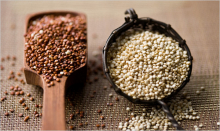- Apr 01, 2013
Did you know The United Nations has declared 2013 the International Year of Quinoa (pronounced keen-wah)? The idea was proposed by the government of Bolivia and received strong support from many Central and South American countries. And why not, this superfood is naturally gluten free and cholesterol free, is considered a complete protein (meaning it provides all 9 essential amino acids) and contains good quantities of calcium, phosphorus and iron. Oh yeah, it tastes good and is extremely versatile.
So how is this once obscure grain getting world-wide attention? Here is a little historical snapshot:
- Evidence suggests quinoa existed as a non-domesticated crop 7,000 years ago. [1]
- It was successfully domesticated for human consumption between 3,000 - 4,000 years ago in the Andean region of Ecuador, Bolivia, Colombia and Peru. [1]
- The Incas, who held the crop to be sacred, referred to quinoa as la chisiya mama or 'mother of all grains'. [2]
- In 1532, Spaniards reached the Andes and destroyed the quinoa fields, replacing them with barley, wheat and potatoes. Quinoa still grew wild, but for centuries quinoa fell into obscurity until there was a revival of interest in the 1970's. [3]
- Over the last few years, quinoa gained a lot of ground in the mainstream market. Minag, Peru's Minstry of Agriculture, reported that the export market for quinoa hit $1.7 billion in 2007. At the end of 2011, that same market was worth $22.3 billion.
- This reflects not only an increase in demand but also an increase in the crop price. Between 2006 and early 2013 quinoa crop prices tripled. In 2011, the average crop value was $3,115 USD per ton with some varieties selling as high as $8,000 per ton. This compares with wheat prices of about $340 per ton. [4]
If you are new to gluten free or just have never tried this tasty little number, here is the best tip I can give you about cooking with quinoa:
The seeds must be rinsed prior to cooking! Quinoa seeds are, by nature, coasted in saponins and that can be resposible for a bitter flavor. Yes, processing methods used in the commercial milling of quinoa removes most of the saponins found in the outer coat of the quinoa seeds. But I find I still get the best results when I rinse first. An effective method is to place the quinoa seeds in a fine-meshed strainer and run cold water over the quinoa while gently rubbing the seeds together in your hands.
- Kolata, Alan L. (2009). "Quinoa". Quinoa: Production, Consumption and Social Value in Historical Context. Department of Anthropology, The University of Chicago.
- Popenoe, Hugh (1989). Lost crops of the Incas: little-known plants of the Andes with promise for worldwide cultivation. Washington, D.C.: National Academy Press.
- Quinoa, Sould Food of the Andes. Vegetarian Paradise.
- Can vegans stomach the unpalatable truth about quinoa?The Guardian.





 Find our products
Find our products FAQs
FAQs Testimonials
Testimonials R&D Projects
R&D Projects